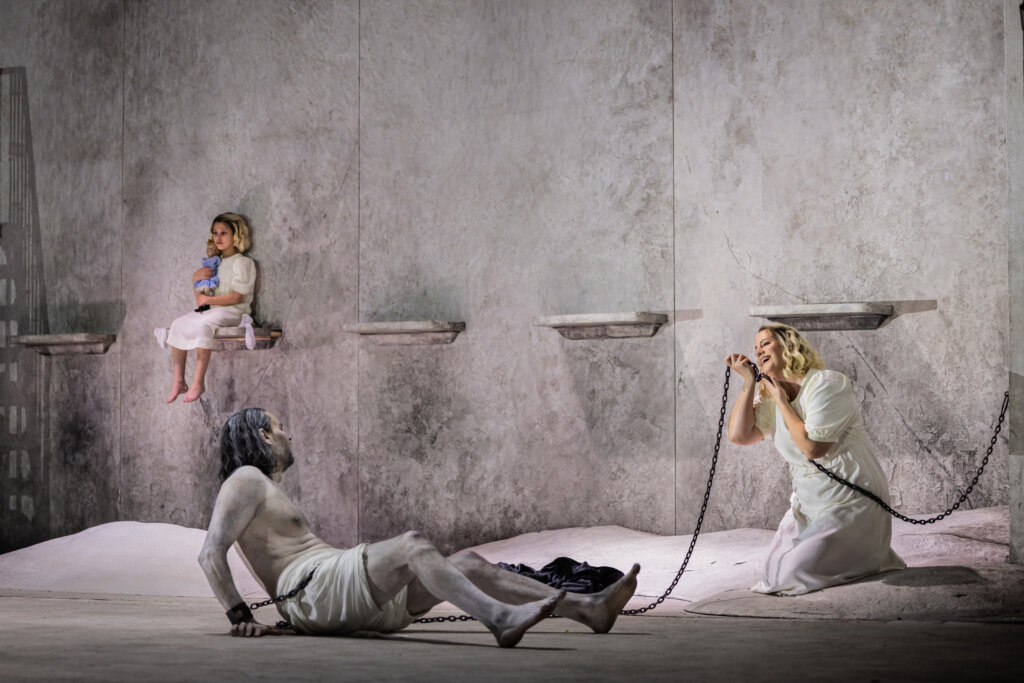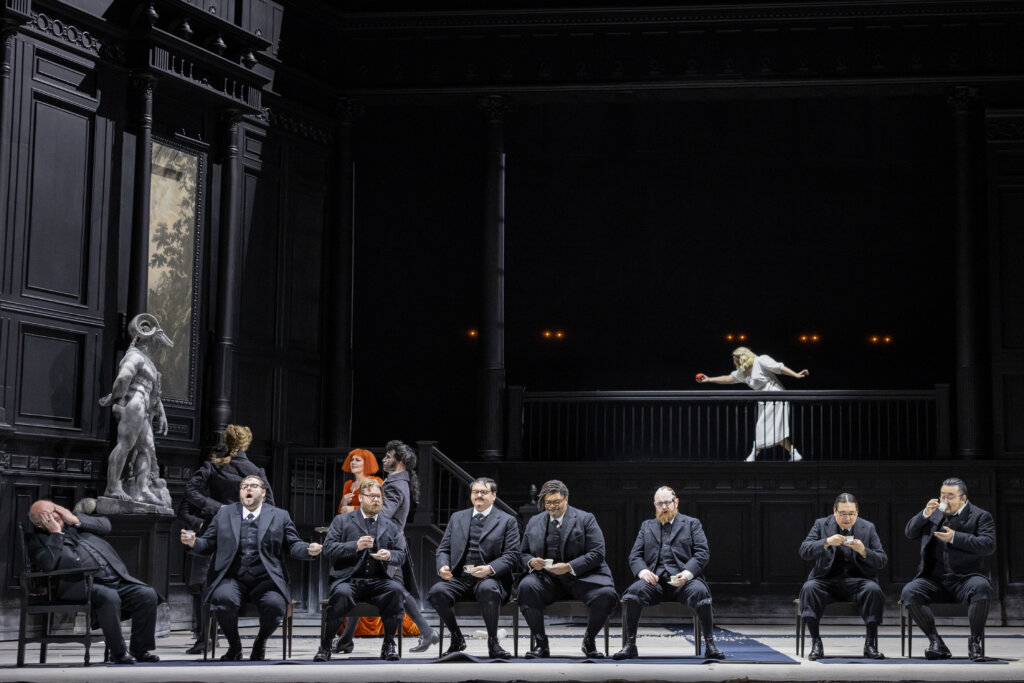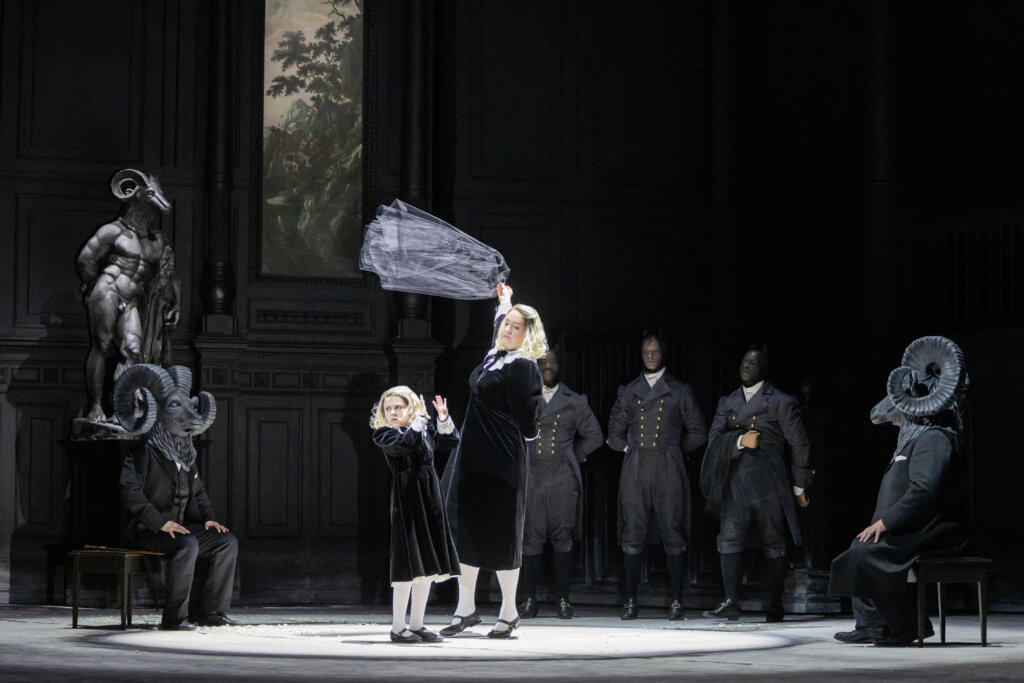Salome and her fractured psyche. Photo by Evan Zimmerman / Met Opera
Director Claus Guth’s production of Salome at the Metropolitan Opera is heavily laden with psychoanalytic symbols. King Herod’s titular stepdaughter, dressed in a Victorian-era children’s dress complete with lace collar and knee socks, is followed around by up to five ghostly children, miniatures of herself. In the show’s centerpiece — the Dance of the Seven Veils — each young girl dances for a menacing figure wearing a black ram’s head: an evocation of sexual abuse. And as these repressed bits of her psyche drift through the background of each scene, the young girls tear their toys to pieces, embodiments of a childhood lost.
It’s fitting for Salome to feel so Freudian. The opera is based on the biblical story of King Herod’s stepdaughter, who demanded the head of John the Baptist — or Jochanaan as he’s called in the play — as a reward for a dance; Oscar Wilde adapted it into a salacious play that Richard Strauss turned it into an opera in 1905. Freud wrote Three Essays on the Theory of Sexuality that same year, theorizing about how childhood sexual experiences shape adult neuroses and obsessions.

In the opera, Herod cannot stop staring at Salome, even though his wife begs him to stop. Separately, the princess falls in love — or lust — with John the Baptist; when he spurns her, she demands his head, which she passionately kisses. Obsession, neurosis, sex: It’s all there.
That the lust in question is perverse is clear. That the lust is Jewish is more subtextual. Though the opera references Jews repeatedly, it also separates Salome from them; she leaves a royal feast complaining about “the Jews” as though she is not, herself, one of them. (The opera’s libretto also features a chorus of five Jewish men who, yes, argue about God, in harmony; in this production, at least, they felt like comic relief.) You must know the biblical text to know that everyone, in fact, is a Jew. But that means that the degenerate, abusive world that has created Salome and her violent desires, is a Jewish one.
Usually, when we think of staging problematic classics, we think of The Merchant of Venice, where most stagings today address that show’s antisemitism directly. Salome, on the other hand, is usually analyzed in terms of misogyny or its themes of abuse and power; Judaism is not a point of focus. But it is, nevertheless, there — and it’s easy to understand the opera as a critique of Jewishness, which it portrays as both corrupt and pedantic.
The Met’s performance pays little overt attention to the libretto’s many mentions of the Jews, focusing instead on Salome’s childhood, and what gave her such a violent relationship to sexuality and desire. “I’m trying to tell the story of a girl growing up in a brutal world full of lies, suddenly realizing that something is wrong and looking for a way to free herself,” said director Guth in the pages of the program. “But in order to get there, she has to destroy the world she’s living in.”

Perhaps Strauss, who sat at the head of the Reich Music Chamber for two years, saw Herod and Salome’s Jewishness as central to the perversity of the opera’s sexuality. While he wrote the opera long before Hitler took power — and based it off Wilde’s play — there’s clear antisemitism to be found in the opera’s portrayal of Jewishness, with its chorus of pedants and perverts. While Strauss fell out of Hitler’s favor before Salome was staged by the Reich, the opera would have fit in with Nazi warnings to German men about the dangerous wiles of Jewish women like Salome.
The Met’s staging emphasizes this connection between dangerous sexuality and Jews, however unintentionally. Herod’s feast attendees wear ram’s heads to pursue a scantily clad woman across the stage, dramatizing their malevolence. And the entire set for Herod’s court is a dark, inky black that contrasts sharply with the chalky white purity of John the Baptist’s surroundings.
It would be easy to read Strauss’ opera as a parable about the need to destroy decadent, Jewish society. But perhaps Strauss didn’t, in fact, take such a dim view of its characters’ sexualities. John the Baptist, whose whiteness Salome describes in great detail, would be an obvious hero for the German opera: Christian, male and Aryan. Instead, he’s comedically inept — and, of course, by the end, he’s dead. Hardly a heroic showing.

In the Met’s staging, it’s Salome who triumphs over masculinity, repression and even Christianity. Her Dance of the Seven Veils is not submission to her stepfather’s desires, but instead a bold accusation against him, exposing her childhood abuse. And when she kisses John the Baptist’s severed head, her prize, she is delighted, feeling no shame though before his death he castigated her for her sinful desires. As disturbing as the scene obviously is, Guth’s staging portrays it as a triumph; Salome has finally defied the controlling powers that have abused her for years, freeing herself both sexually and psychologically. Where traditionally Herod’s soldiers kill the princess at the end of the opera, in the Met’s production, she simply disappears into a fog, another freedom.
But what are we to make of the sinister Jews that flit through the background, leering at the women and drooling over Salome? They’re as much Salome’s enemies as John the Baptist or Herod. Is their characterization antisemitic?
Perhaps the show’s truest Freudian read — and in a way, its most Jewish — is in its rejection of simple answers. Salvation is to be found in the complexities of the individual psyche, not in God. After all, shortly after Salome demanded John the Baptist’s head, the Temple fell and the ancient Judaism, led by high priests and kings, ended. All of Judaism after that has been a search for meaning guided by human knowledge — rabbis and sages and the Talmud — not Godly omnipotence or royal decrees. In Guth’s production, Salome eschews Jochanaan’s prophecies and her stepfather’s control, choosing instead to try to figure out her own vision of sexuality, selfhood and meaning. What could be more Jewish?

